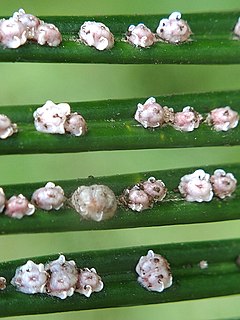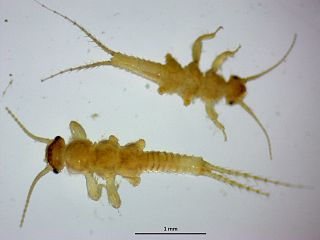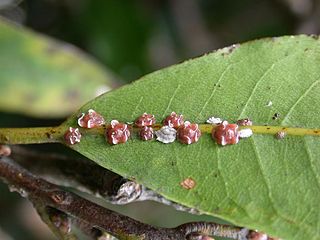
Convolvulaceae, known commonly as the bindweed or morning glory family, is a family of about 60 genera and more than 1,650 species of mostly herbaceous vines, but also trees, shrubs and herbs, and also including the sweet potato and a few other food tubers.

Scale insects are small insects of the order Hemiptera, suborder Sternorrhyncha. Of dramatically variable appearance and extreme sexual dimorphism, they comprise the superfamily Coccoidea. Adult females typically have soft bodies and no limbs, and are concealed underneath domed scales, extruding quantities of wax for protection. Some species are hermaphroditic, with a combined ovotestis instead of separate ovaries and testes. Males, in the species where they occur, have legs and sometimes wings, and resemble small flies. Scale insects are herbivores, piercing plant tissues with their mouthparts and remaining in one place, feeding on sap. The excess fluid they imbibe is secreted as honeydew on which sooty mold tends to grow. The insects often have a mutualistic relationship with ants, which feed on the honeydew and protect them from predators. There are about 8,000 described species.

Nyctaginaceae, the four o'clock family, is a family of around 33 genera and 290 species of flowering plants, widely distributed in tropical and subtropical regions, with a few representatives in temperate regions. The family has a unique fruit type, called an "anthocarp", and many genera have extremely large pollen grains.
Baphala homoeosomella is a species of snout moth in the genus Baphala. It was described by Zeller in 1881, and is found in Cuba, the Virgin Islands, Panama, Guyana, Colombia and Brazil.

Ochthebius is a genus of minute moss beetles in the family Hydraenidae. There are at least 460 described species in Ochthebius.

Thanatophilus is a genus of carrion beetles in the family Silphidae. There are about 12 described species in Thanatophilus.
Elipsocus is a genus of damp barklice in the family Elipsocidae. There are more than 20 described species in Elipsocus.

Nemoura is a genus of spring stoneflies in the family Nemouridae. There are more than 190 described species in Nemoura.

Stilobezzia is a genus of predaceous midges in the family Ceratopogonidae. There are more than 330 described species in Stilobezzia.
Zeridoneus is a genus of dirt-colored seed bugs in the family Rhyparochromidae. There are at least three described species in Zeridoneus.

Xeralictus is a genus of sweat bees in the family Halictidae. There are at least three described species in Xeralictus.

Cimolus is a genus of leaf-footed bugs in the family Coreidae. There are at least four described species in Cimolus.

Pseudopamera is a genus of dirt-colored seed bugs in the family Rhyparochromidae. There are about nine described species in Pseudopamera.
Dictyobia is a genus of tropiduchid planthoppers in the family Tropiduchidae. There are at least four described species in Dictyobia.

Cissites is a genus of blister beetles in the family Meloidae. There are at least four described species in Cissites.
Ptycta is a genus of common barklice in the family Psocidae. There are more than 150 described species in Ptycta.

Ceroplastes cirripediformis, known generally as the barnacle scale or barnacle wax scale, is a species of soft scale insect in the family Coccidae.

Ceroplastes rubens, known generally as the red wax scale or pink wax scale, is a species of soft scale insect in the family Coccidae.

Ceroplastes ceriferus, the Indian wax scale, is a species of scale insect in the family Coccidae. It is native to southern Asia and has spread to many other parts of the world.














